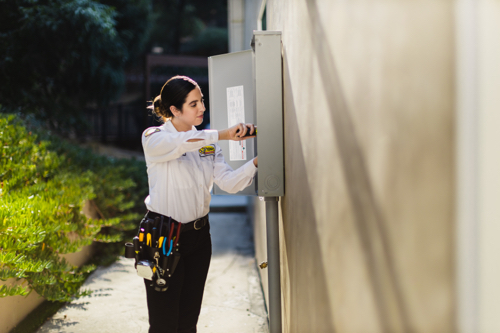Where Should Ground and Neutral Be Bonded? 
Electricity is one of nature’s most volatile forces, and it can be deadly when not properly controlled. That’s why modern household electrical systems incorporate grounding, circuit breakers and other safety measures to protect against dangerous faults and short circuits.
For these safeguards to work, however, the ground and neutral wires must be bonded inside the main service panel. To see why, let’s start by taking a closer look at how your electrical system keeps you safe when things go haywire.
Grounding: A Safe Path for Fault Currents
Grounding is a key aspect of electrical safety, but its purpose and function are often misunderstood. In your home, the electrical system is split into circuits consisting of hot, neutral and ground wires. When you flip a switch or plug in an appliance, current travels through the hot wire and energizes the device. It then returns to the main panel and out to the transformer, completing the circuit. At least, that’s how it’s supposed to work.
When something disrupts this loop for example, a loose connection in an outlet or a wire with damaged insulation — it causes a fault in the circuit. This can open a path for current to escape and flow unpredictably through any conductive materials nearby. In addition to the obvious risk of shock or electrocution, this can damage appliances and create a serious fire hazard. Luckily, that’s where grounding comes into play.
Think of ground wires like spillways in a dam. When all is going well, they shouldn’t carry any electricity at all. It’s only when a fault or power surge threatens to overwhelm a circuit that they become critical, providing a safe and predictable path for current to be carried away. This is known as grounding because the electricity is commonly described as being dissipated into the earth, but more on that in a moment.
How Circuit Breakers Prevent Overloads
If ground wires are like electrical spillways, circuit breakers are more like security officers. In essence, their function is to monitor the current flowing through the system and take immediate action if there’s any suspicious activity. Of course, most circuit breakers aren’t actually that smart, but they get the job done thanks to an ingenious bit of engineering.
Each circuit is built with a thermal or magnetic element that effectively acts as a kill switch. If a fault causes the circuit to draw too much current, it can generate enough heat or magnetic force to activate the element and trip the switch. This cuts the supply of power almost instantaneously, rendering the circuit safe.

This design is simple, clever and reliable, but if you’ve been paying attention, you might have an obvious question. If it takes a lot of electricity for these elements to trip, how can circuit breakers work when ground wires harmlessly dissipate fault currents into the earth?
Completing the Circuit: Bonding Ground And Neutral
The truth is that “grounding” is something of a misnomer. While ground wires are indeed connected directly to the earth, they aren’t just meant to dump electricity into the soil. To clear faults safely, wayward currents need a low-impedance path directly back to the transformer. That’s precisely why bonding the ground and neutral wires is so important, creating a continuous circuit that allows fault currents to activate the circuit breaker.
In fact, it’s more than just a recommended best practice. Under the National Electrical Code (NEC), neutral-to-ground bonding is mandatory for residential electrical systems throughout the United States. However, it should only be done at the first means of service disconnect, which is the main electrical panel in most homes. Throughout the rest of the electrical system, the ground and neutral wires should always remain separate to ensure stable system voltage and prevent parallel current paths.
Need a helping hand with your home electrical system? Don’t put up with any malarky, call Mister Sparky! From electrical grounding and safety inspections to wiring and service panel upgrades, our trained and licensed electricians in Tampa, FL are standing by to serve all your electrical needs.
